Exploring Cost-effectiveness in Transplantation and Cellular Therapies: Insights from Dr. Amar Kelkar at the Tandem Meetings I Transplantation & Cellular Therapy Meetings of ASTCT® and CIBMTR®
Amar H. Kelkar, MD, presented findings on the cost-effectiveness of transplantation therapy during the 2024 Tandem Meeting.
Amar H. Kelkar, MD, presented findings on the cost-effectiveness of transplantation therapy during the 2024 Tandem Meeting.

In the Tandem Meetings I Transplantation & Cellular Therapy Meetings of ASTCT® and CIBMTR® Administrators Track, Dr. Amar Kelkar form Dana Farber Cancer Institute presented concepts that should be in the minds of all health professionals interested in transplantation and cellular therapies today.
Some of the concepts that were broken down by Dr. Kelkar were:
Comparative efficacy: To compare the efficacy of two or more treatments in any given indication, such as a randomized clinical trial.
Cost comparison: to compare the costs of two interventions of similar effectiveness in each regional or institutional context.
Cost-effectiveness: the degree to which something is effective in relation to its cost.
Quality adjusted life year (QALY): estimates the quality and the quantity of life lived. One QALY is equal to one year in perfect health.
Willingness to pay threshold (WTP): the number of resources a system is willing to pay for the gain of 1 QALY, which may vary across regions.
Incremental cost-effectiveness ratio (ICER): the ratio of the difference in price of two interventions over the difference in their efficacy (measured in QALY).
To walk the audience through these concepts, he used a recent cost-effectiveness analysis recently published in Annals of Internal Medicine. This study included randomized trials of ZUMA-7 and TRANSFORM that showed improved outcomes in second-line chimeric antigen receptor T-cells for patients with high-risk diffuse large B-cell lymphoma compared to standard of care that includes high-dose chemotherapy and autologous hematopoietic cell transplant.
This study showed an ICER of $684,225 per QALY for axi-cel and $1,171,909 per QALY for liso-cel, potentially increasing US healthcare spending by $6.8 billion USD over a 5-year period, concluding that although clinical outcomes improved incrementally, costs should be lowered to achieve cost-effectiveness. For axi-cel to break even at a generous willingness to pay threshold of $200,00 USD, the authors found a price of $320,000, which is ~$100,000 below list prices.
Dr. Kelkar concluded cost-effectiveness studies are important to assess the benefit of a treatment for society. These studies can be used by health authorities as evidence to negotiate or set prices. Another way to improve cost-efficacy is using better diagnostic and predictive tools to ensure patients who are most likely to benefit receive the therapy.
Newsletter
Stay up to date on recent advances in the multidisciplinary approach to cancer.